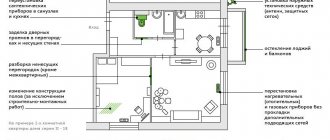Share on social media networks:
Many apartment owners have a desire to change the layout. I would like to make a spacious studio out of a cramped Khrushchev apartment, design the entrance to the living room in the form of an arch, connect two rooms into one - in a word, there can be many reasons. And from time to time in different cities situations arise when the owner makes repairs in his own apartment, and soon the Housing Inspectorate comes to him and orders him to redo everything as it was. Troubles happen for one simple reason - the owner did not ask which walls can be demolished in a panel house, as well as in a brick one, and which ones are better left alone. We will now discuss the subtleties of this difficult process.
What types of walls are there?
Are you interested in whether it is possible to demolish walls in a panel house? It is possible, but not all. The vast majority of modern apartments have two types of walls:
- load-bearing, they are also capital;
- partitions.
So, it is possible to break a partition in an apartment, but not a load-bearing wall, because the strength of the house depends on them. This is especially true in panel high-rise buildings, where the slightest violation of the strength can lead to trouble, or even tragedy. It is possible that, due to an unauthorized wall, the house will simply collapse; special consequences should be expected from the demolition of a load-bearing wall. Therefore, when wondering whether it is possible to break a load-bearing wall in a panel house, you need to think three hundred times and consult with the management company or the architecture department of the local administration.
Average price for demolition
The cost of dismantling walls made of panels on average in the Russian Federation depends on:
required scope of work;- project complexity;
- costs associated with the delivery of tools and a team of workers;
- urgency of the order;
- time of year (prices are more expensive in winter);
- region (region).
On average, dismantling work according to the price lists of Russian companies is 100-120 rubles/m2 . In Moscow Region and St. Petersburg, the price for dismantling can range from 180-250 rubles/m2. Construction organizations often provide discounts and programs for their clients, so that each of them can receive a nice bonus.
Private individuals working under contract offer their services from 80 rubles/m2, but they do not provide a guarantee for the work performed. In addition, the owner of the premises will personally have to control the entire scope of the process according to the plan.
What is redevelopment?
Don’t think that in your own apartment you can do whatever your left leg wants. Of course, no one has the right to tell you what color to paint the walls or what tiles to stick in the bathroom. Regular repairs do not need to be coordinated with anyone except other household members. But if you want to move the toilet to another room or install a water-heated floor, you will have to take care not to violate the interests of your neighbors. It is precisely to ensure that after your repair that serious conflicts do not arise, sometimes leading to lawsuits and large compensation, that the local administration exists. She is the one who has the right to give permission for such global changes in your life.
A radical reconstruction of residential premises, when communications are transferred or walls are moved, is called redevelopment. Before we figure out which walls cannot be demolished, let's look at what redevelopment is and what you need to be able to carry it out. There are many options:
- moving walls or partitions;
- division of rooms;
- changing the position of window and door openings;
- reconstruction of dark storerooms, as well as vestibules;
- construction of stairs inside the apartment;
- reconstruction or relocation of bathrooms;
- moving kitchens;
- replacing stoves from gas to electric;
- expansion of the room, resulting in a reduction in the kitchen, bathroom or hallway;
- glazing of balconies.
So not only moving a wall, but also something as banal as glazing a loggia is considered a redevelopment and requires a certain amount of approval.
Dismantling the partition: procedure
Regardless of what material the partition is made of, you must constantly follow the dismantling technology. The danger to humans is that without protective materials, you can contaminate your lungs or injure your eyes or legs.
People who neglect to wear sturdy shoes when working with a sledgehammer often suffer from broken toes. Here's how to do the work:
- First you need to prepare by purchasing goggles and a construction respirator to protect against dust and fine dirt, as well as durable boots and gloves. Then they turn off the electricity, cover furniture and equipment, and pipelines.
- Now you can begin the reconstruction: first remove the decorative layer, then the door and door frame, as well as other parts.
- They begin to destroy the wall: usually work starts from top to bottom so that there is no collapse of the partition.
- Destruction begins from the door opening, or from the center. To get rid of excess dust, the surface should be sprinkled with water.
Completion of work - garbage removal. Particular care should be taken with wooden structures. After breaking them, you can put a splinter, so it is better to work with gloves.
A responsible approach to dismantling structures made of any materials, drawing up the necessary documents and coordinating the work is the key to the successful demolition of a wall. Compliance with safety rules and knowledge of the intricacies of working with different materials will help you complete the process quickly and without injury.
Bearing wall
Owners of apartments in city high-rise buildings sometimes renovate their apartments completely - moving the bathroom, installing additional windows, and so on and so forth. But not everyone decides to undertake global alterations. There are the most popular types of redevelopment. These include, along with glazing a loggia or replacing a slab, the demolition of walls in a panel house.
The walls of a house serve many purposes. They not only protect owners from adverse weather conditions. For example, they support ceilings. Strength calculations are made taking into account the load-bearing capacity of all walls. Of course, the reserve is always taken into account, but each demolished main wall makes the high-rise building less reliable, and that is why it is not allowed to make redevelopment at your own discretion. So before you start global changes, you need to figure out which walls are load-bearing, that is, structural elements of the entire house:
- As a rule, they are located perpendicular to the beams - the ends of the floor beams lie precisely on the load-bearing walls.
- In most high-rise buildings, the floors are made of concrete slabs, and their edges are laid on the surface of the load-bearing walls.
If you find it difficult to determine where the floors of your apartment lie, try to find load-bearing walls by other criteria. They can be:
- external;
- between apartments;
- between individual blocks.
Inside the apartment itself, most often only partitions are installed, but one cannot be completely sure of this - in large dwellings there may be load-bearing walls inside. You can distinguish a load-bearing wall from a partition, for example, by its dimensions:
- the main wall (for example, external) must have a thickness of at least 140 mm, and sometimes 180-200 mm;
- in a brick house, the structural elements are usually even thicker - 380-400 mm;
- The thickness of the partition ranges from 80 mm to 120 mm.
Material
Main walls differ from partitions in material:
- The first ones are made of brick or reinforced concrete blocks, including lightweight ones
- Partitions are mostly made of gypsum concrete - at least in panel houses. This material is used in brick buildings and for partitions, but the masonry is different.
Tools
Before tearing down the partition between the kitchen and the room, you should prepare the tools. They can be:
- axe;
- mount;
- putty knife;
- chisel;
- hacksaw;
- pliers;
- hammer;
- screwdrivers.
All this will be needed only if manual dismantling is provided. But you can’t take a concrete wall with such devices. To dismantle a partition made of durable materials, you can use:
- grinder;
- hammer drill;
- diamond drilling rig.
What are we removing?
No normal resident would think of demolishing the outer wall or the one that separates the apartment from the common corridor. But with those that are inside the apartment, there are different nuances, and confusion arises from time to time. So the first thing you need to do, if you are interested in what kind of load-bearing or non-load-bearing walls can be demolished in a panel house, is to contact the technical inventory bureau. There you can get a floor plan with everything listed:
- the main walls are boldly outlined;
- the partitions are indicated by thin lines.
Important! The BTI service is paid, but since you may need such a plan more than once when you receive approvals, you will have to get it.
Getting permissions
Where does the demolition of a load-bearing wall in a panel house begin? With specialist consultation. In different cities, different structures deal with such issues, so the most reasonable thing is to start by contacting the management company servicing your home. If it does not have a specialist of a similar profile on staff, you will at least be sent to an organization that does have such an engineer. As a rule, this is the architectural department of the local administration.
Important! This is a very important point, because it will be necessary to make strength calculations taking into account the fact that the load will no longer fall on one of the walls of your house. It is also possible that you will have to radically change the power supply circuit or other communications. A specialist will give a technical opinion on the possibility of demolishing the wall you want to remove.
What's next?
Once you have the floor plan and technical report in your hands, you can safely contact the Housing Inspectorate. She must approve the demolition - not the redevelopment project, but the very possibility of removing this or that structure.
There are usually no problems with partitions, but permanent walls are rarely allowed to be removed. Don't be self-willed. Even if the Housing Inspectorate does not come to you right after the renovation, it is quite possible that you will someday want to sell or exchange your home. If the redevelopment has not been agreed upon, very serious difficulties may arise with this. After permission in principle for demolition has been received, you need to order the project from a licensed design organization and coordinate it with all authorities, and then order a new floor plan from the BTI - it will be different.
Important! Uncoordinated redevelopment sometimes leads to court decisions that are unpleasant for the owner - the apartment can even be confiscated.
Hiring specialists in a construction company
Calling specialists for dismantling is a balanced solution if it is possible to contact a trusted company with experienced workers. There are situations in which contacting a professional is the only way to safely disassemble the structure. For example, if it consists of several layers of different materials and there is electrical wiring or other communications.
You should contact a specialist if the partition is re-installed or if old materials were used during installation (worn tongue-and-groove structure, wood). If the partition is made with a door frame, and you have never dismantled it, you can turn to specialists for careful work in order to preserve the door.
Dismantling the wall
So, you have received permission in principle to demolish the partition that bothers you. What to do next? Then you can begin to actually demolish the walls in the apartment.
Option 1
If the house is brick, the interior partitions are made of bricks laid on their sides, so they are thinner:
- Remove the block above the doorway.
- Disassemble the area above the opening.
- Disassemble the areas to the right and left of the door, trying to do it symmetrically and gradually.
Option 2
Disassembling a partition in a panel house is a bit more dirty and labor-intensive, and also unsafe. You will need tools:
- perforator;
- hammer;
- Bulgarian;
- metal cutting disc.
The partition only looks like cardboard. In fact, it is made of rebar encased in plaster, meaning it will have to be cut and broken. In this case, it is better to cut off small pieces, because the slab is quite heavy, and if it falls on you, at best you will have to call an ambulance:
- Mark the area you will separate first.
- Use a hammer drill to follow the contour of this area.
- Beat off the pieces of plaster hanging on the wire with a hammer so that they do not interfere with cutting the reinforcement.
- Cut wire and metal rods.
- Remove the piece of slab.
- Knock out and cut out the remaining fragments of the partition in the same way.
Important! The perimeter of each piece should not exceed 4 m.
Demolition of non-load-bearing partitions between rooms in 2021
Unauthorized reconstruction Despite the fact that many works on changing residential premises do not require permission, their implementation is completed by entering new information into the apartment’s registration certificate. If this is not done, then the redevelopment or reconstruction falls into the category of unauthorized, that is, illegal.
This is the main document regulating this type of relationship. It applies to both apartment owners and tenants of social or specialized housing. But even before the RF Housing Code came into force, various rules and regulations regarding the operation of the housing stock were in force and continue to be in force to this day. They contain detailed questions:









